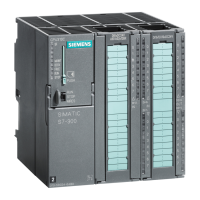Communication
3.3 S7 connections
CPU 31xC and CPU 31x, Technical data
Manual, Edition 08/2004, A5E00105475-05
3-27
Connection points
An S7 connection between modules with communication capability is established between
connection points. The S7 connection always has two connection points: The active and
passive connection points:
• The active connection point is assigned to the module that establishes the S7 connection.
• The passive connection point is assigned to the module that accepts the S7 connection.
Any module that is capable of communication can thus act as an S7 connection point. At the
connection point, the established communication link always uses one S7 connection of the
module concerned.
Transition point
If you use the routing functionality, the S7 connection between two modules capable of
communication is established across a number of subnets. These subnets are
interconnected via a network transition. The module that implements this network transition
is known as a router. The router is thus the point through which an S7 connection passes.
Any CPU with a DP or PN interface can be the router for an S7 connection. You can
establish a certain maximum number of routing connections. This does not limit the data
volume of the S7 connections.
See also
Connection resources for routing (Page 3-31)
3.3.2 Assignment of S7 connections
There are several ways to allocate S7 connections on a communication-capable module:
• Reservation during configuration
• Allocating connections via programming
• Allocating connections during commissioning, testing and diagnostics routines
• Allocating connection resources to OCMS services
Reservation during configuration
One connection resource each is automatically reserved on the CPU for PG and OP
communication. Whenever you need more connection resources (for example, when
connecting several OPs), configure this increase in the CPU properties dialog box in
STEP 7.
Connections must also be configured (using NetPro) for the use of S7 communication. For
this purpose, connection resources have to be available, which are not allocated to PG/OP
or other connections. The required S7 connections are then permanently allocated for
S7 communication when the configuration is uploaded to the CPU.

